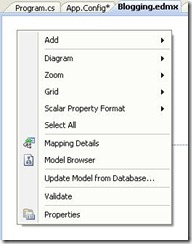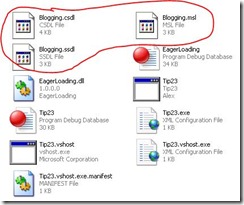Tip 45 – How to swap EF metadata at runtime.
Background
By default the Entity Framework embeds its metadata inside your assembly as a resource.
It also puts a connection string in the App or Web Config that references those resources something like this:
<add name="BloggingEntities" connectionString="metadata=res://*/Blogging.csdl|res://*/Blogging.ssdl|res://*/Blogging.msl;provider=System.Data.SqlClient;provider connection string="Data Source=.\SQLEXPRESS;Initial Catalog=TipsDatabase;Integrated Security=True;MultipleActiveResultSets=True"" providerName="System.Data.EntityClient" />
This makes it incredibly easy to get started:
using (BloggingEntities ctx = new BloggingEntities())
{
NOTE: the use of res://* to tell the EF to look inside the assemblies resources for the various bits of metadata.
Problem
But embedding the metadata as a resource also means it is essentially immutable.
What if you need to change it at runtime?
There are lots of reasons why you might want to change the metadata at runtime, but probably the most likely is that in production you have to deal with a DBA who has a different set of database design ideas.
Typically this means you have to make some database changes which require some storage model (SSDL) and mapping (MSL) changes.
Doing so is perfectly okay, indeed it is one of the big benefits of using the Entity Framework, so long as the conceptual model or CSDL -- what the developer programs against -- remains unchanged.
Solution
So how do you plug in a different MSL and SSDL at runtime?
Here are the steps involved:
Step 1:
Get hold of the ‘metadata artifacts’:
Right click on the designer canvas and click Properties:
Set 'Metadata Artifact Processing' to 'Copy to Output Directory':
Build and look in the bin\debug (or bin\release) directory:
Step 2:
Now you have the CSDL/MSL/SSDL as files, it is easy to replace one or more (generally the SSDL and MSL) with a version that matches your environment. So you can have one set for Development and another for Production.
Then all you need to do is modify your connection string to point to the right set of files, something like this:
var connStr =
@"metadata=.\Blogging.csdl|.\Production.ssdl|.\Production.msl;
provider=System.Data.SqlClient;
provider connection string=""
Data Source=.\SQLEXPRESS;
Initial Catalog=TipsDatabase;
Integrated Security=True;
MultipleActiveResultSets=True
""";
using (BloggingEntities ctx = new BloggingEntities(connStr))
{
Notice that now the connection string uses .\ rather than res://* which tells the EF to look in the same directory as the application for the metadata.
That’s all there is to it.
NOTE: EF connection strings can be a little tricky, what with nested provider connection strings, metadata and providers, thankfully though there is an EntityConnectionStringBuilder class to help out.


